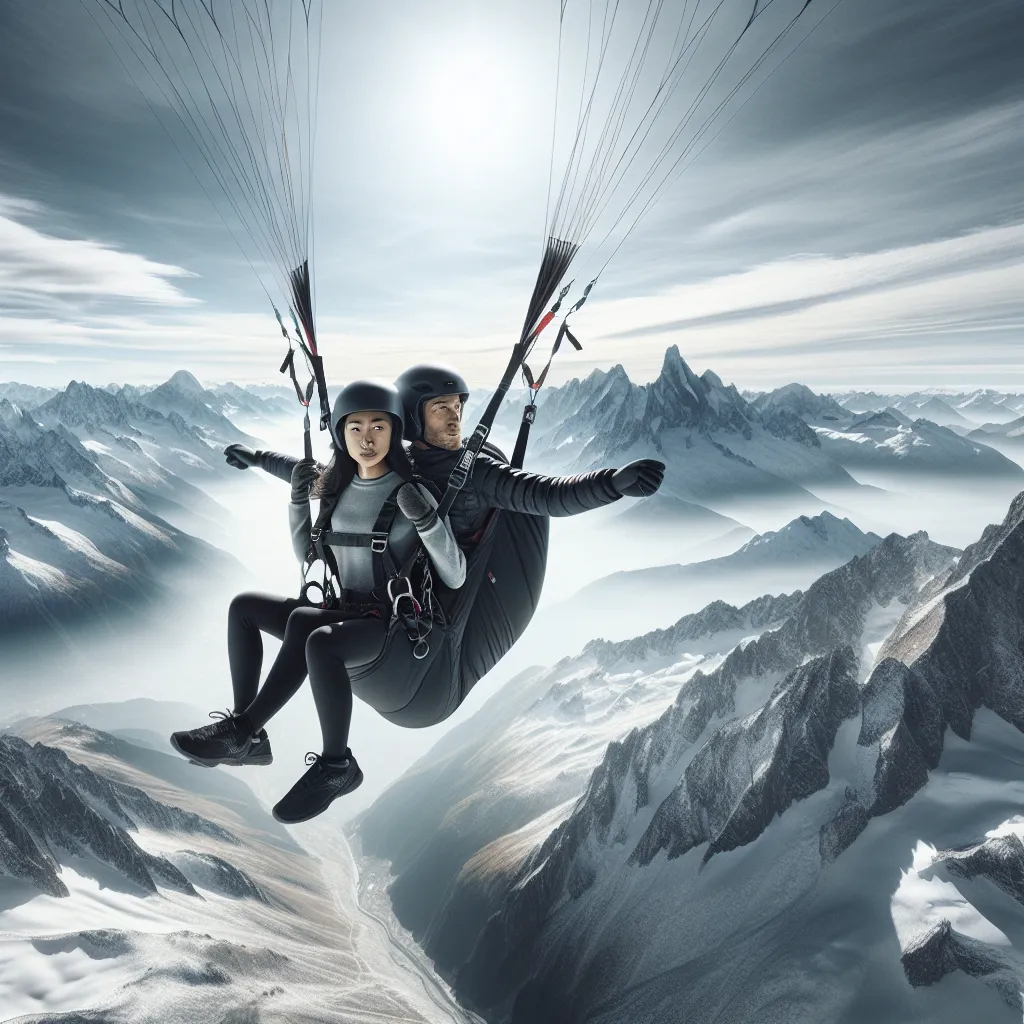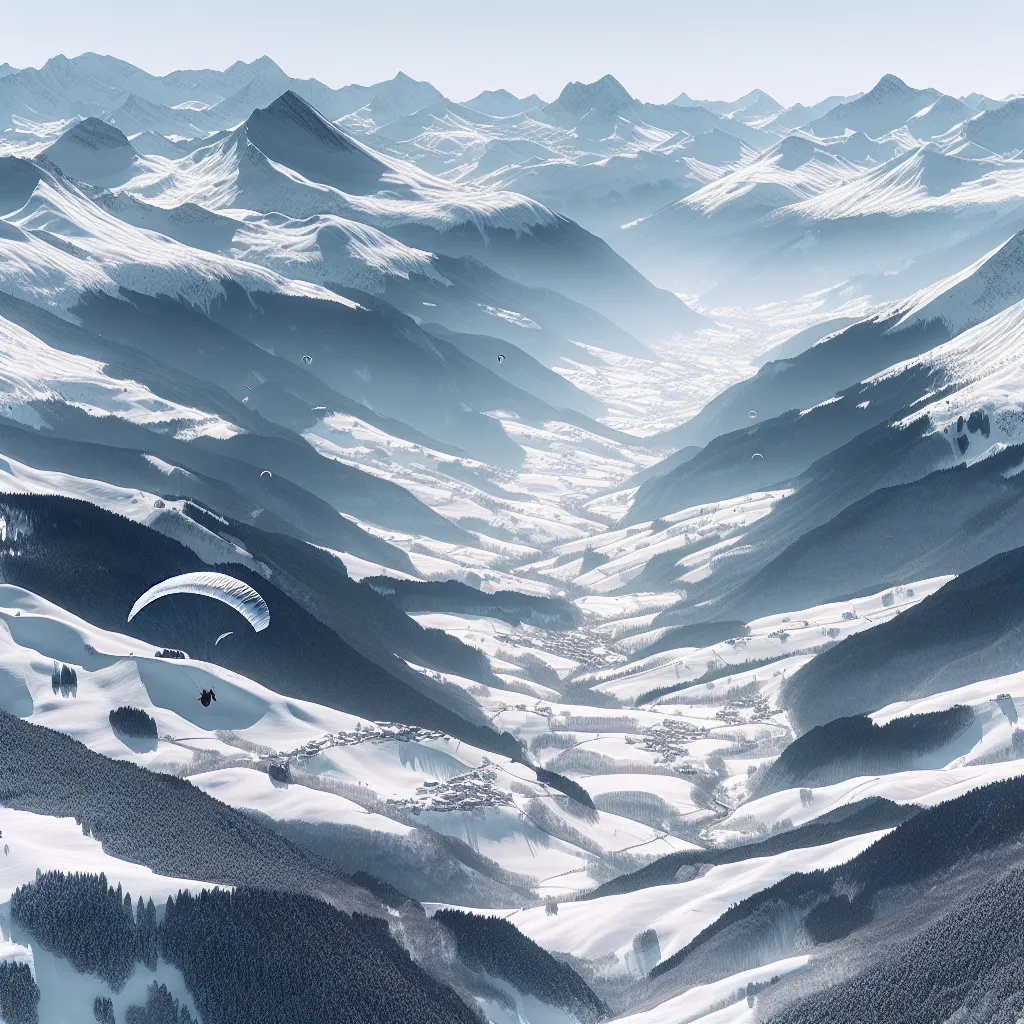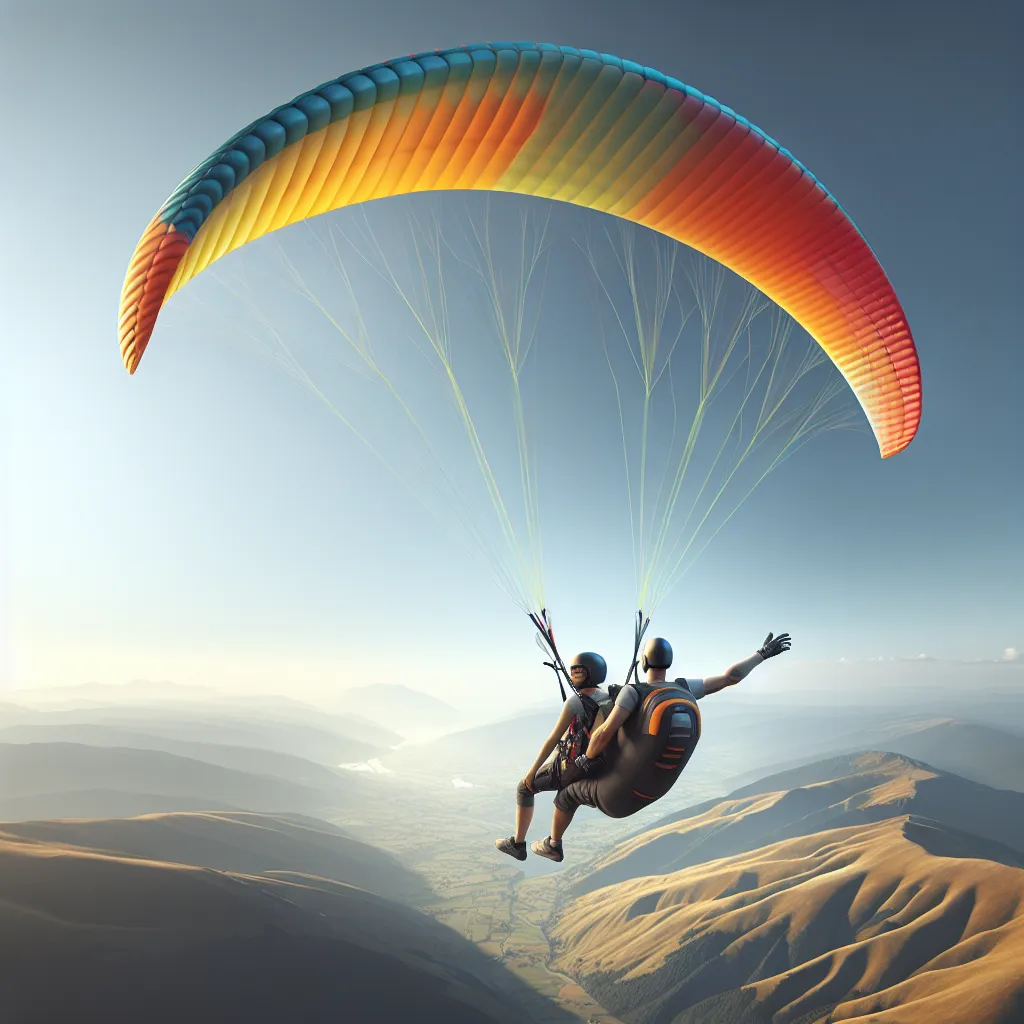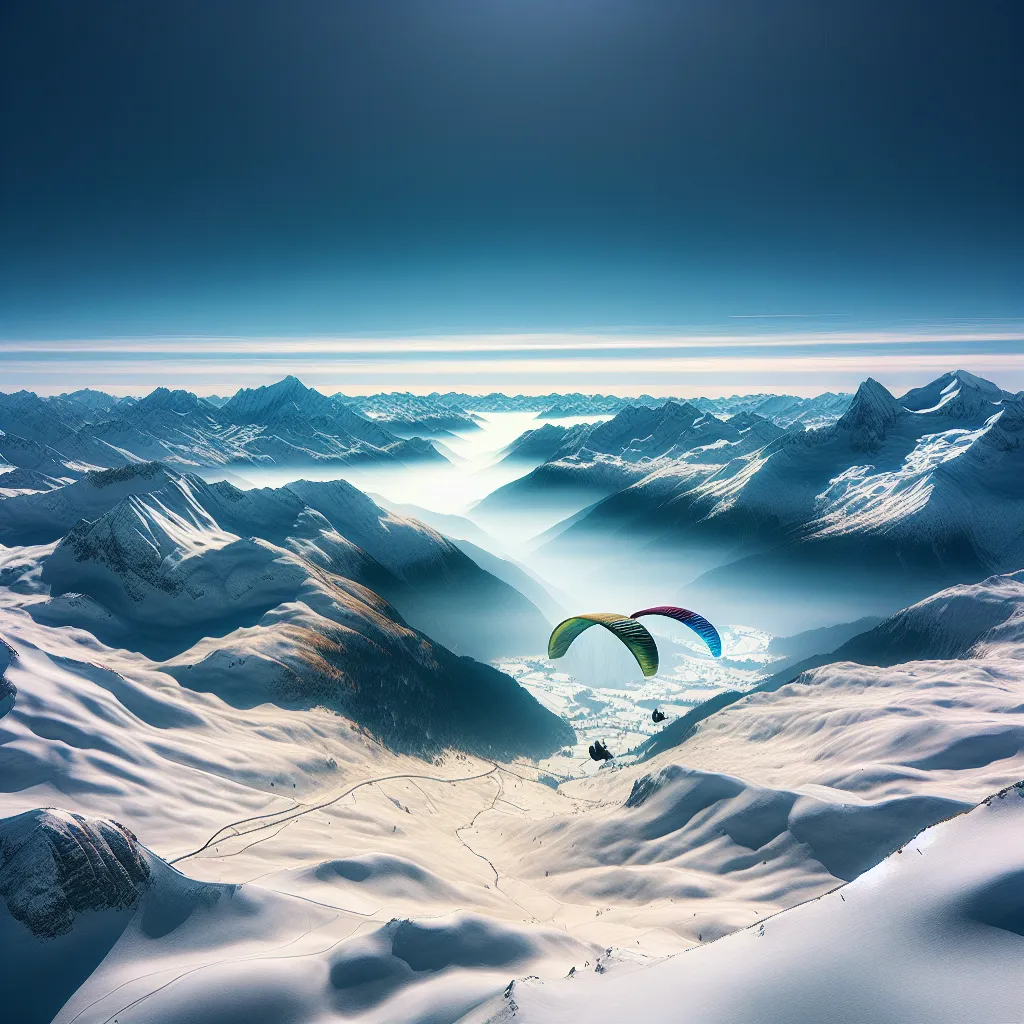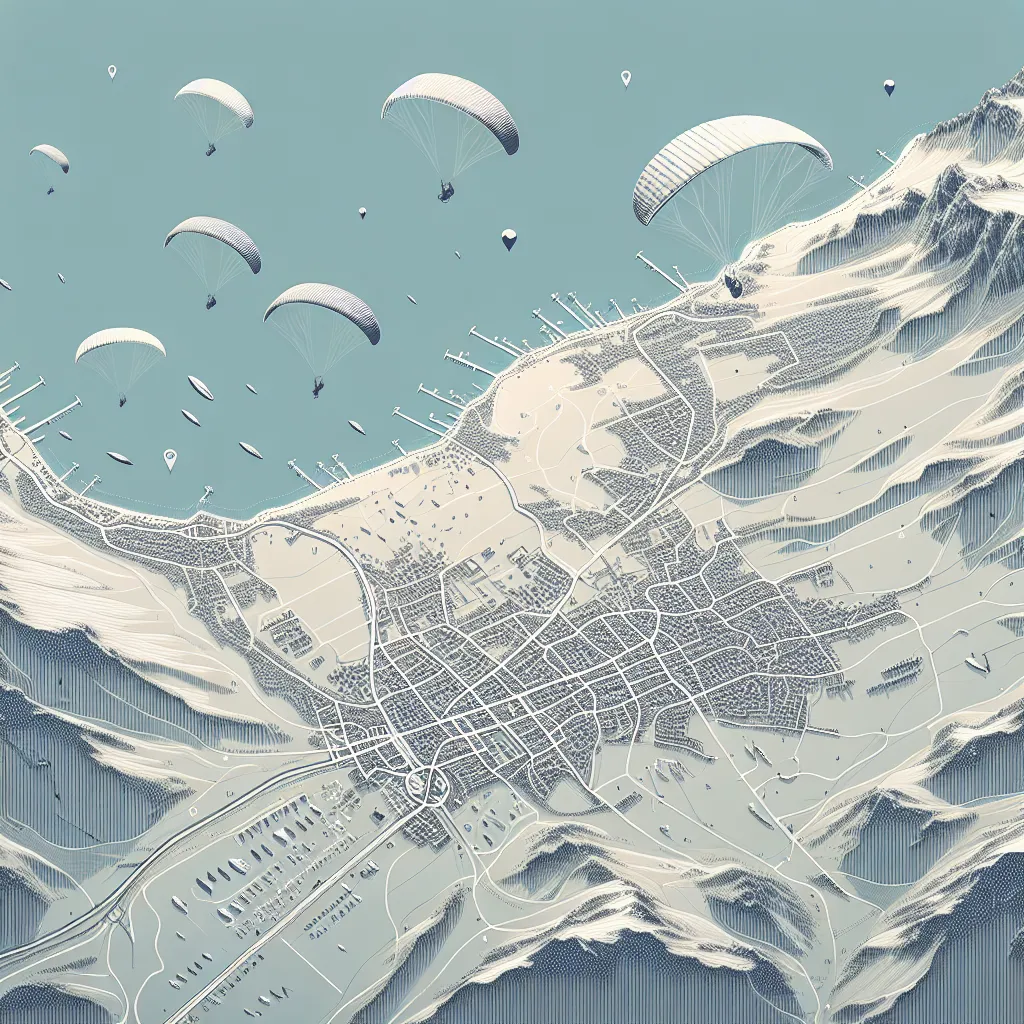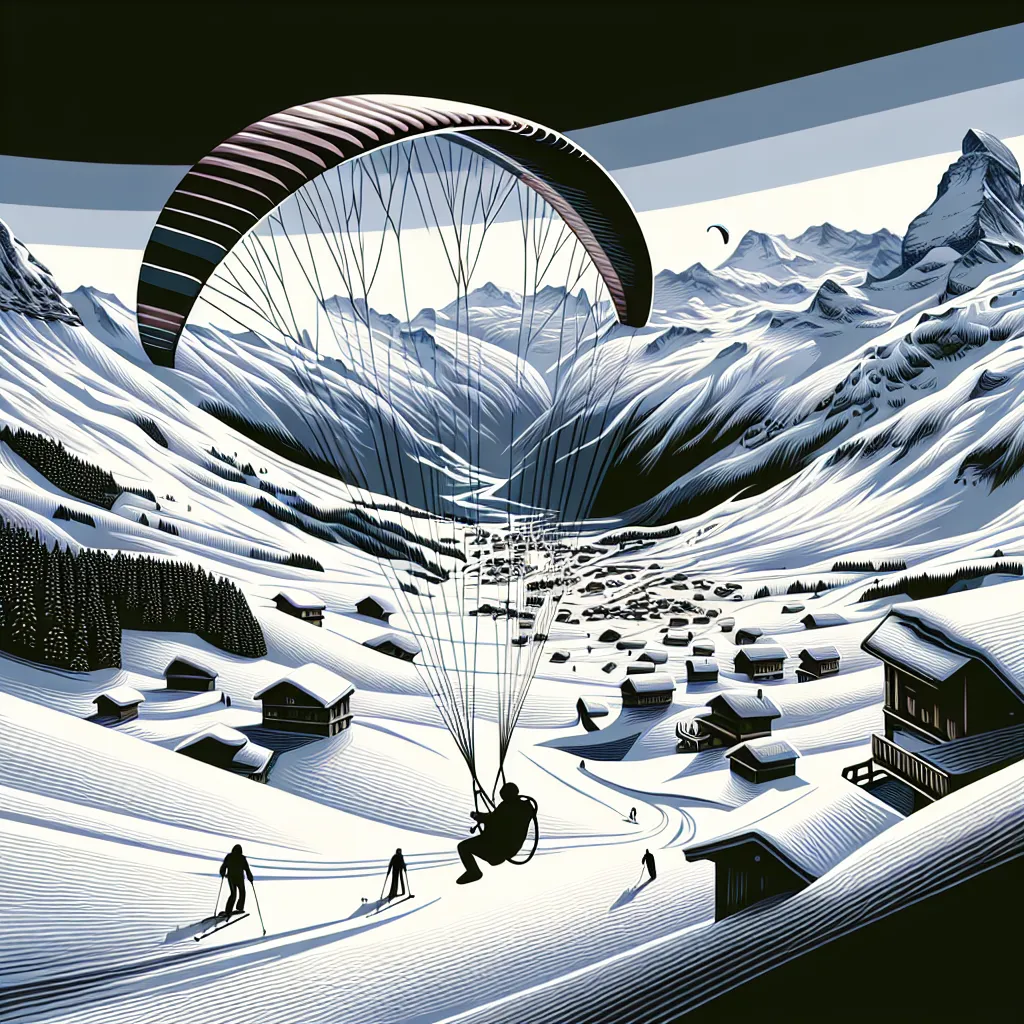Winter Paragliding in the Pyrenees: Soaring Above Snow-Covered Peaks
Experience the Pyrenees from a breathtaking new perspective with tandem paragliding flights. Soar above snow-covered mountains, forests, and valleys with expert pilots—family-friendly winter adventures in the Couserans.

Introduction: The Mountains from a Different Perspective
However beautiful mountains are from the ground, they reveal entirely different character from above. What takes hours to climb unfolds in minutes beneath your feet. Ridges and valleys that seem disconnected on the ground reveal their relationships. The scale becomes comprehensible—you see how villages nestle in valleys, how forests transition to alpine terrain, how rivers carve through the landscape. And in winter, when snow transforms everything into geometric patterns of white, shadow, and stone, the Pyrenees become almost abstract art.
Tandem paragliding offers this aerial perspective without requiring years of training or significant athletic ability. You're securely harnessed to an experienced, certified pilot who handles all the technical aspects—reading air currents, controlling the wing, managing takeoff and landing. Your job is simple: relax, enjoy, breathe in the extraordinary experience of human flight. No engine noise interrupts the silence. No enclosed cockpit separates you from the environment. Just you, your pilot, the wing above, and the Pyrenean winter spreading endlessly below.
The Couserans region, particularly around Guzet and Moulis, provides exceptional paragliding conditions. The mountain geography creates reliable thermals and ridge lift. The terrain offers varied landscapes—high peaks, forested slopes, valleys, traditional villages—making flights visually spectacular. And winter, contrary to what you might assume, offers excellent flying conditions with stable weather patterns and that crystalline visibility that makes distant Spanish peaks seem touchable.

Pyrenees Aerial Majesty
What to Expect: Your Tandem Flight Experience
If you've never paraglided before, the prospect might seem intimidating. Actually, tandem paragliding is remarkably straightforward and far less scary than many people imagine. Understanding what happens helps reduce any anxiety.
Pre-Flight Briefing: Your pilot meets you at the designated location (often a launch site accessible by car or short walk) and explains the basics. How the harness works. What to do during takeoff (usually just run forward a few steps as the wing inflates). How you'll be positioned during flight (seated in a comfortable harness—many describe it as sitting in a swing). What to expect during landing. The briefing is concise—10-15 minutes—and pilots are experienced at calming nervous first-timers.
Takeoff: This is often the moment people worry about most, but it's surprisingly gentle. As the wing inflates and generates lift, you feel yourself becoming lighter. A few running steps (the pilot is right there, supporting you), and suddenly your feet leave the ground. There's no dramatic drop or stomach-lurch—just a smooth transition from running to floating. Within seconds, you're airborne, and what seemed scary moments before becomes pure exhilaration.
The Flight: Once aloft, a profound sense of peace descends. The silence is remarkable—just wind rushing past, the occasional flutter of the wing, perhaps your pilot pointing out landmarks below. You're seated comfortably in the harness (genuinely comfortable—these aren't rudimentary straps but well-designed seats), and the motion is gentle. The pilot controls everything, sometimes explaining what they're doing, sometimes letting silence reign. You can chat, ask questions, take photos, or simply absorb the experience. Flights typically last 15-30 minutes depending on conditions, though some extended flights can reach 45 minutes or longer when thermals are strong.
Landing: As smooth as takeoff. The pilot positions you near the landing zone, explains what to do (usually just lift your legs and let the pilot's feet touch first), and you glide to a gentle stop. Most people's immediate reaction? "Can we go again?"

Tandem Flight in Action
Safety: Understanding the Reality vs. Perception
Many people perceive paragliding as dangerous extreme sport. The reality is quite different. Modern tandem paragliding, conducted by certified pilots in appropriate conditions, has an excellent safety record—statistically safer than many everyday activities including driving to the launch site.
Several factors ensure safety:
Pilot Certification: In France, tandem paragliding pilots must hold specific professional certifications (Brevet d'État or equivalent) requiring extensive training, examination, and ongoing education. Your pilot has completed hundreds or thousands of flights, undergone rigorous testing, and maintains current certification. The pilots operating around Guzet and Moulis have deep knowledge of local conditions—they know how wind patterns work in these specific valleys, which conditions are flyable and which require cancellation, where thermals form, and how weather develops in these mountains.
Equipment Standards: Paragliding equipment meets strict European safety standards. Wings undergo regular inspection and replacement schedules. Harnesses include backup systems. All equipment is specifically designed and tested for the forces and conditions of paragliding. The tandem equipment is even more robust than solo equipment, built for heavier loads and maximum stability.
Weather Assessment: Flights only proceed in appropriate conditions. Pilots carefully evaluate wind speed and direction, thermal activity, cloud base, visibility, and forecast changes. If conditions aren't right, flights are postponed—no exceptions. Responsible pilots turn down far more potential flying days than they accept, prioritizing safety over revenue.
Conservative Flight Planning: Tandem pilots fly conservatively. They maintain altitude margins, avoid aggressive maneuvers, stay within established flying zones, and plan multiple landing options. The goal is smooth, enjoyable flights, not dramatic aerobatics (unless you specifically request more exciting flying and conditions permit).
Physical Requirements: Paragliding is accessible to most people. Weight limits exist (typically 30-100kg for passengers, though this varies by pilot and equipment), but age isn't limiting—children from about 8 years old can fly (with parental consent), as can seniors well into their 70s or beyond if reasonably mobile. You need to be able to run a few steps for takeoff and stand for landing, but no special fitness is required.
Winter Flying: Special Conditions and Advantages
Winter paragliding in the Pyrenees offers distinct advantages over summer flying, though it requires appropriate preparation.
Weather Stability: Winter weather patterns in the Pyrenees are often more stable than summer's volatile thunderstorm conditions. Once a high-pressure system settles in, you can get several consecutive days of excellent flying weather—clear skies, gentle winds, smooth air. This stability makes flight planning more reliable and conditions more comfortable.
Exceptional Visibility: Winter air is typically clearer than summer's, with less atmospheric haze and humidity. On good days, visibility extends 100+ kilometers—you can see from the Atlantic-facing peaks clear to the Mediterranean-side mountains. The Spanish Pyrenees are clearly visible, sometimes even the distant shimmer of the sea. This exceptional clarity makes winter flights particularly spectacular photographically.
Snow-Enhanced Scenery: The snow transforms landscapes dramatically. Mountains that appear complex and detailed in summer become studies in pure form—white slopes, dark rock faces, the geometric patterns of forests, villages standing out against white surroundings. Frozen lakes gleam like mirrors. The sun creates long shadows that emphasize terrain relief. From above, winter Pyrenees look almost otherworldly.
Thermal Activity: While winter thermals are generally weaker than summer's, they're often smoother and more predictable. Experienced pilots can work winter thermals to extend flights significantly, gently circling upward in rising air, gaining altitude to explore further or simply extend the experience.
Temperature Management: The main challenge of winter flying is cold. At altitude, temperatures drop significantly, and the wind chill from airspeed can be substantial. However, with appropriate clothing (detailed below), this is entirely manageable. Many pilots carry extra jackets and gloves for passengers. The cold is genuine but not unbearable, and most people find that excitement and adrenaline keep them from focusing on temperature.

Winter Flight Conditions
Family Flying: Sharing the Experience
Paragliding works beautifully for families, with everyone able to participate (age and weight permitting). Watching family members take off and land, sharing the experience, comparing perspectives afterward—these become memorable holiday highlights.
Many families fly sequentially—one parent goes first (often the more nervous one, discovering it's actually fine), then the children, then the other parent. Everyone launches from the same site and lands in the same area, so family members can watch each other. The excitement is contagious—seeing someone land with a huge grin immediately eases nervousness about your own flight.
Children and Paragliding: Kids often adapt to paragliding more easily than adults. They have less accumulated fear, trust more readily, and simply enjoy the adventure. Most pilots report that children are excited rather than scared, asking questions throughout the flight, pointing out landmarks, disappointed when it's time to land. The minimum age is typically 8 years old, though some pilots accept younger children if they meet weight requirements and seem emotionally ready. Parental consent is required for minors.
Creating Shared Memories: There's something powerful about family members experiencing something completely new together. Paragliding isn't like skiing where some family members are experts and others struggle. Everyone is equally new to it, equally amazed by it. The shared vulnerability and shared wonder create bonds and memories that last long after the holiday ends. Years later, you'll be saying "Remember when we went paragliding in the Pyrenees?" and everyone will have vivid recall.
Photography and Video: Many pilots offer photo/video packages, capturing your flight from their perspective (helmet cameras or handheld). These provide wonderful souvenirs—seeing yourself airborne, the landscape spreading below, the pure joy on your face. Even smartphone photos from flights can be spectacular, though be sure to secure your phone (wrist strap essential) as dropping it means permanent loss.
Practical Information and Preparation
Booking Flights: Paragliding in the Couserans operates through professional pilots and schools like Parapente Family based in Moulis. Booking can be done directly, through the St Girons tourism office, or often through your accommodation. Advance booking is essential, particularly during French school holidays. Winter weather can cause cancellations, so build flexibility into your schedule—don't plan paragliding for your only free afternoon.
Cost: Tandem flights typically cost €80-120 per person depending on flight duration (15-30+ minutes) and whether photos/video are included. This is reasonable for such a unique experience. Family packages and group discounts are sometimes available.
What to Wear:
- Warm layers: Base layer, fleece or down jacket, windproof outer layer
- Warm pants: Ski pants or thick hiking trousers
- Sturdy footwear: Hiking boots or solid trainers (must protect ankles, allow running)
- Warm gloves: Essential—your hands get cold quickly
- Hat or headband: Covering ears (some helmets don't protect ears from wind)
- Sunglasses: Secure strap essential—sun glare at altitude is intense
- Sunscreen: UV exposure is significant at altitude
Pilots often provide extra jackets and gloves if needed. Helmets are always provided.
What to Bring:
- Smartphone or camera (with secure wrist strap)
- Water
- Excitement and open mind
Weather Dependency: Understand that flights are weather-dependent and cancellations are possible. If your pilot cancels, it's because flying would be unsafe or unpleasant—trust their judgment. Reputable operators reschedule or refund canceled flights.
Physical Conditions: You must disclose any relevant medical conditions (heart problems, epilepsy, recent surgery, pregnancy, etc.). Most conditions don't preclude flying, but pilots need to know. Weight limits are real—typical range is 30-100kg, though this varies by pilot and equipment.
Meeting Point: Pilots typically meet you at a designated location (often near Moulis or specific launch sites in the Couserans). Clear instructions are provided upon booking. Launches usually require 15-30 minute drives from St Girons or Guzet.
The Value of a Central Base
Paragliding operates from specific launch sites depending on wind direction and conditions. In the Couserans, primary sites are near Moulis and various points around the Guzet area. A centrally located accommodation base provides significant advantages.
Loge de Chateau Pouech, situated near St Girons, places you within 30-45 minutes of primary paragliding sites. This positioning offers flexibility—if weather at one launch site isn't suitable, pilots can often fly from alternative sites that you're still conveniently close to. The central location also means you're not committed to staying in small mountain villages with limited amenities.
For multi-activity holidays (highly recommended), central accommodation makes logistics effortless. Paraglide one day, ski another, snowshoe another, explore villages the next. Each activity launches from different locations, so central positioning maximizes your options while minimizing driving.
Additionally, paragliding often involves some waiting and flexibility around weather windows. Being based in the St Girons area means you're not trapped in a remote mountain village if weather delays flights—you can explore the town, visit markets, enjoy restaurants, and generally make productive use of time while staying responsive to your pilot's updates about conditions.

Launch Site Accessibility
Combining Paragliding with Other Winter Activities
Paragliding works excellently as part of varied winter holidays. Most people find that a single tandem flight (or perhaps one per family member) provides the aerial experience without dominating the entire holiday. A typical week might include:
- 2-3 days skiing for those who want mountain action
- Paragliding day (allowing flexibility for weather)
- Trapper workshop or snowshoeing for different outdoor experiences
- Village exploration and thermal baths for cultural immersion and relaxation
- Free time for spontaneous activities or weather contingencies
This varied approach creates richer holidays where different experiences complement each other. The aerial perspective from paragliding gives you overview of terrain you might hike or ski later. The ground-level activities provide detailed knowledge of landscapes you've seen from above. Each perspective enriches the others.
Many families report that paragliding becomes the unexpected highlight—something they booked almost as an afterthought but which created the most powerful memories. There's something about human flight, about seeing familiar earth from an utterly new perspective, that captures imagination in ways predictable activities don't quite match.

Complete Winter Experience
Conclusion: The Freedom of Flight
Human beings have dreamed of flying for millennia. Tandem paragliding transforms that dream into accessible reality—not through complex machinery or years of training, but through the simple elegance of a fabric wing catching invisible air currents, lifting you into the sky above some of Europe's most beautiful mountains.
The experience is difficult to fully convey to those who haven't tried it. The profound silence after takeoff. The gentle sensation of floating rather than falling. The way familiar landscapes reveal entirely new patterns and relationships from above. The sense of freedom that comes from being airborne, moving through three-dimensional space rather than walking along two-dimensional surfaces. The crystalline clarity of winter Pyrenees stretching to distant horizons. These aren't just visual or physical sensations—they touch something deeper, some fundamental human longing to transcend normal constraints and see the world from new perspectives.
In the Couserans, professional pilots make this experience safe, accessible, and thoroughly memorable. Whether you're naturally adventurous or somewhat nervous, whether you're 10 years old or 70, whether you're seeking adrenaline or peaceful contemplation, tandem paragliding delivers experiences you'll remember and talk about for years.
Based at accommodations like Loge de Chateau Pouech, with its central location and access to the full range of Couserans activities, you can easily incorporate paragliding into varied, balanced winter holidays. Book a flight, trust your pilot, take a few running steps, and discover what birds have known forever—the Pyrenees are spectacular from above, and the experience of flight is worth whatever nervousness you must overcome to achieve it. Sometimes, the best holiday memories come from saying yes to experiences that initially seem scary but prove to be pure magic.
